Purple flowers are some of the most beautiful and captivating flowers in the world. With a range of shades from deep purple to light lavender, these flowers add a touch of sophistication and elegance to any garden.
Purple flowers have always been a symbol of sophistication, elegance, and beauty. These blooms come in a range of shades from deep purple to lavender and can bring a touch of royalty to any garden. In this article, we’ll take a look at some of the most popular purple flower names, their characteristics, and the best way to care for them.
Purple is a beloved color in the world of flowers and there are numerous varieties of purple flowers that add beauty and vibrancy to any garden or bouquet. From the majestic and regal Iris to the delicate and dainty Lilac, from the bold and striking Allium to the charming and lovely Anemone, there are many purple flowers to choose from. Other examples of purple flowers include the vibrant Coneflower, the lovely Bell Heather, the exquisite Cattleya Orchid, the fragrant Heliotrope, and the charming Pansy. No matter what your preferences are, there is a purple flower out there for everyone to enjoy.
Want to learn all flower’s name? this blog will help you to find all the flower’s names in English and all language as well.
Table of Contents
Toggle31 Purple Flowers Name List
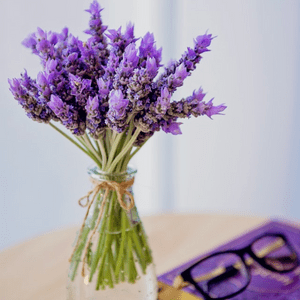
#1. Lavender Flower
Lavender is a popular and versatile plant that is known for its beautiful blooms and soothing fragrance. Here is a breakdown of its scientific name, plant type, sunlight needs, plant size, growing zones, and soil needs:
- Scientific Name: Lavandula angustifolia
- Plant Type: Herbaceous perennial shrub
- Sunlight Needs: Full sun
- Plant Size: 1-3 feet in height and 1-2 feet in width
- Growing Zones: 5-9
- Soil Needs: Well-draining, alkaline soil with a pH of 7.0 or higher

#2. Bellflower Flower
Bellflowers are a popular and beautiful plant that is known for their bell-shaped blooms and versatility in gardens and landscapes.
- Scientific Name: Campanula spp.
- Plant Type: Perennial or biennial flower
- Sunlight Needs: Full sun to partial shade
- Plant Size: Varies depending on species, from 6 inches to 6 feet in height and width
- Growing Zones: Varies depending on species, from USDA hardiness zones 3 to 9
- Soil Needs: Well-draining, fertile soil with a neutral to alkaline pH
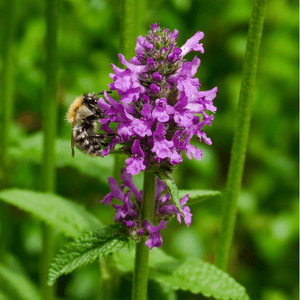
#3. Alpine Betony Flowers
Alpine betony flowers, also known as wood betony, are a unique and eye-catching plant that are native to Europe and Asia.
- Scientific Name: Stachys alpina
- Plant Type: Perennial flower
- Sunlight Needs: Full sun to partial shade
- Plant Size: 6-12 inches in height and 12-18 inches in width
- Growing Zones: USDA hardiness zones 3-7
- Soil Needs: Well-draining, fertile soil with a neutral to alkaline pH

#4. Lavender Flower
Lavender is a popular and versatile plant that is known for its beautiful blooms and soothing fragrance. Here is a breakdown of its scientific name, plant type, sunlight needs, plant size, growing zones, and soil needs:
- Scientific Name: Lavandula angustifolia
- Plant Type: Herbaceous perennial shrub
- Sunlight Needs: Full sun
- Plant Size: 1-3 feet in height and 1-2 feet in width
- Growing Zones: 5-9
- Soil Needs: Well-draining, alkaline soil with a pH of 7.0 or higher

#5. Iris
Iris flowers are known for their showy, colorful blooms that can be shades of purple, blue, yellow, white, and pink. The flowers have three petals and three sepals, which are often similar in appearance and form a distinctive symmetrical shape. Iris is often used in flower arrangements and is a popular garden plant due to its striking appearance and easy maintenance.
- Scientific Name: Iris germanica
- Plant Type: Iris is a perennial flowering plant that grows from rhizomes (a type of root system) and can reach a height of up to 3 feet (90 cm).
- Sunlight Needs: Iris requires full to partial sunlight in order to thrive. It prefers at least six hours of sunlight each day, but can tolerate some shade.
- Plant Size: The size of the Iris plant can vary depending on the cultivar, but on average it grows to be about 2-3 feet (60-90 cm) tall and wide.
- Growing Zones: The Iris flower is hardy in USDA growing zones 3-10. It can grow in many different regions, but prefers moderate to cool temperatures.
- Soil Needs: Iris prefers well-draining soil that is slightly acidic to neutral in pH (around 6.0 to 7.5). It can tolerate a variety of soil types, but it is important to avoid waterlogged or poorly-draining soil, as this can lead to root rot.

#6. Lilac Flower
Lilac flowers are known for their fragrant, showy blooms that can range in color from white to deep purple. The flowers are produced in large clusters, and can be used in flower arrangements. Lilac is often used as a landscape plant, and is prized for its beautiful flowers and low maintenance requirements.
- Scientific Name: Syringa vulgaris
- Plant Type: Lilac is a deciduous shrub that can grow up to 20 feet (6 meters) tall and 12 feet (3.6 meters) wide. It is often grown as a landscape plant, but can also be trained to grow as a small tree.
- Sunlight Needs: Lilac prefers full sunlight, but can tolerate some shade.
- Plant Size: The size of the Lilac plant can vary depending on the cultivar and growing conditions, but on average it grows to be about 6-12 feet (1.8-3.6 meters) tall and wide.
- Growing Zones: The Lilac flower is hardy in USDA growing zones 3-7, and can be grown in some parts of zone 8. It is native to Europe and Asia, but has been widely cultivated in many regions of the world.
- Soil Needs: Lilac prefers well-draining soil that is slightly alkaline (pH 6.5-7.5). It can tolerate a variety of soil types, but does best in soil that is rich in organic matter.

#7. Calla Lily
Calla Lily flowers are known for their elegant, trumpet-shaped blooms that can be white, yellow, pink, or red. The flowers are produced on long, slender stalks and can be used in flower arrangements. Calla Lily is often used as a houseplant or in garden beds, and is prized for its beautiful flowers and easy care.
- Scientific Name: Zantedeschia aethiopica
- Plant Type: Calla Lily is a perennial plant that grows from a bulb and can reach a height of up to 3 feet (90 cm). It is often grown as a potted plant, but can also be grown outdoors in mild climates.
- Sunlight Needs: Calla Lily prefers bright, indirect sunlight or partial shade. It can tolerate some direct sunlight, but too much can damage the leaves and flowers.
- Plant Size: The size of the Calla Lily plant can vary depending on the cultivar and growing conditions, but on average it grows to be about 1-3 feet (30-90 cm) tall and 1-2 feet (30-60 cm) wide.
- Growing Zones: Calla Lily is hardy in USDA growing zones 8-10. It is native to southern Africa, but has been widely cultivated in many regions of the world.
- Soil Needs: Calla Lily prefers well-draining soil that is rich in organic matter. It can tolerate a range of soil types, but does best in soil that is slightly acidic to neutral (pH 6.0-7.0).
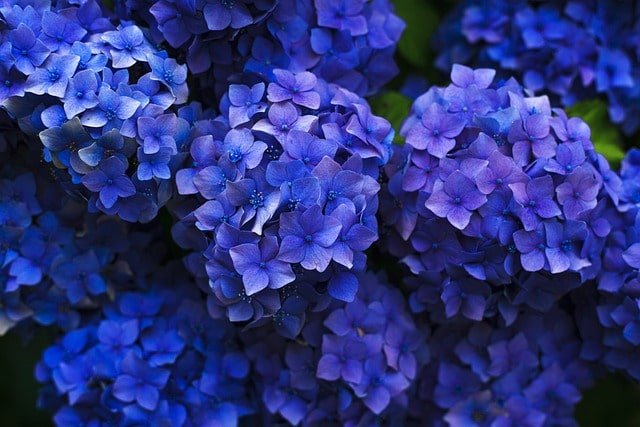
#8. Hydrangea Flower
Hydrangea flowers are known for their large, showy blooms that can be white, pink, blue, or purple, depending on the cultivar and soil pH. The flowers are produced in clusters, and can be used in flower arrangements. Hydrangea is often used as a landscape plant, and is prized for its beautiful flowers and foliage.
- Scientific Name: Hydrangea macrophylla
- Plant Type: Hydrangea is a deciduous shrub that can grow up to 10 feet (3 meters) tall and wide. It is often grown as a landscape plant, but can also be grown in containers.
- Sunlight Needs: Hydrangea prefers partial shade, with some morning sun and afternoon shade. Too much direct sunlight can cause the leaves and flowers to wilt.
- Plant Size: The size of the Hydrangea plant can vary depending on the cultivar and growing conditions, but on average it grows to be about 4-6 feet (1.2-1.8 meters) tall and wide.
- Growing Zones: Hydrangea is hardy in USDA growing zones 5-9. It is native to Japan and Korea, but has been widely cultivated in many regions of the world.
- Soil Needs: Hydrangea prefers well-draining soil that is rich in organic matter. It can tolerate a range of soil types, but does best in soil that is slightly acidic to neutral (pH 5.5-6.5).

#9. Allium Flower
Allium flowers are known for their unique, globular blooms that are made up of many small, individual flowers. The flowers can be pink, purple, white, or yellow, depending on the cultivar. Allium is often used in mixed borders or as a focal point in the garden, and is prized for its unusual and eye-catching flowers.
- Scientific Name: Allium
- Plant Type: Allium is a bulbous perennial plant that is a member of the onion family. It is grown for its showy, spherical flowers that can range in size from a few inches to several feet in diameter.
- Sunlight Needs: Allium prefers full sunlight to partial shade.
- Plant Size: The size of the Allium plant can vary depending on the cultivar and growing conditions, but on average it grows to be about 1-3 feet (30-90 cm) tall and wide.
- Growing Zones: Allium is hardy in USDA growing zones 3-9. It is native to Asia, Europe, and North America, but has been widely cultivated in many regions of the world.
- Soil Needs: Allium prefers well-draining soil that is rich in organic matter. It can tolerate a range of soil types, but does best in soil that is slightly alkaline to neutral (pH 6.0-7.5).

#10. Crocus Flower
Crocus flowers are known for their bright, cheerful blooms that can be yellow, purple, white, or a combination of these colors. The flowers are produced in early spring, often before the leaves have emerged.
- Scientific Name: Crocus
- Plant Type: Crocus is a bulbous perennial plant that is grown for its showy, cup-shaped flowers that appear in early spring.
- Sunlight Needs: Crocus prefers full sunlight to partial shade.
- Plant Size: The size of the Crocus plant can vary depending on the cultivar and growing conditions, but on average it grows to be about 4-6 inches (10-15 cm) tall and wide.
- Growing Zones: Crocus is hardy in USDA growing zones 3-8. It is native to Europe, North Africa, and the Middle East, but has been widely cultivated in many regions of the world.
- Soil Needs: Crocus prefers well-draining soil that is rich in organic matter. It can tolerate a range of soil types, but does best in soil that is neutral to slightly alkaline (pH 6.0-7.5).
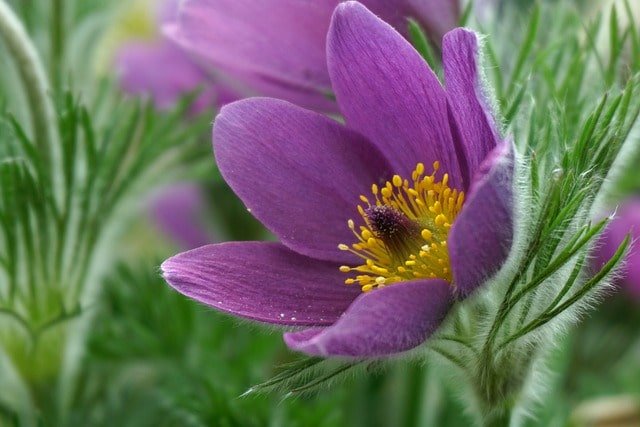
#11. Pasque Flower
Pasque Flower flowers are known for their early bloom time, often appearing in early spring when little else is blooming. The flowers are produced on hairy stems, and can be blue, purple, red, or white, depending on the cultivar.
- Scientific Name: Pulsatilla vulgaris
- Plant Type: Pasque Flower is a herbaceous perennial plant that is grown for its showy, cup-shaped flowers that appear in early spring.
- Sunlight Needs: Pasque Flower prefers full sunlight to partial shade.
- Plant Size: The size of the Pasque Flower plant can vary depending on the cultivar and growing conditions, but on average it grows to be about 6-12 inches (15-30 cm) tall and 8-12 inches (20-30 cm) wide.
- Growing Zones: Pasque Flower is hardy in USDA growing zones 4-8. It is native to Europe, Asia, and North America.
- Soil Needs: Pasque Flower prefers well-draining soil that is neutral to slightly alkaline (pH 6.5-7.5). It can tolerate a range of soil types, but does best in soil that is sandy or gravelly.

#12. Fuchsia Flower
Fuchsia flowers are known for their unique, pendant blooms that are made up of many small, individual flowers. The flowers can be single or double, and are often fragrant. Fuchsia is often used in hanging baskets, containers, or as a border plant in the garden.
- Scientific Name: Fuchsia
- Plant Type: Fuchsia is a woody shrub that is grown for its showy, pendant flowers that can range in color from pink, red, and purple to white.
- Sunlight Needs: Fuchsia prefers partial shade to full shade.
- Plant Size: The size of the Fuchsia plant can vary depending on the cultivar and growing conditions, but on average it grows to be about 2-3 feet (60-90 cm) tall and wide.
- Growing Zones: Fuchsia is hardy in USDA growing zones 10-11, but can also be grown as an annual in cooler climates. It is native to Central and South America, but has been widely cultivated in many regions of the world.
- Soil Needs: Fuchsia prefers well-draining soil that is rich in organic matter. It can tolerate a range of soil types, but does best in soil that is slightly acidic to neutral (pH 6.0-7.0).

#13. Aster Flower
Aster flowers are known for their bright, cheerful blooms that can be single or double, depending on the cultivar. They typically bloom in late summer or fall, providing a burst of color in the garden when many other plants are fading.
- Scientific Name: Aster
- Plant Type: Aster is a herbaceous perennial plant that is grown for its daisy-like flowers that come in a range of colors, including white, pink, purple, blue, and red.
- Sunlight Needs: Aster prefers full sunlight, but can also tolerate some shade.
- Plant Size: The size of the Aster plant can vary depending on the cultivar and growing conditions, but on average it grows to be about 1-6 feet (30-180 cm) tall and 1-3 feet (30-90 cm) wide.
- Growing Zones: Aster is hardy in USDA growing zones 3-9, depending on the cultivar. It is native to North America, Europe, and Asia.
- Soil Needs: Aster prefers well-draining soil that is rich in organic matter. It can tolerate a range of soil types, but does best in soil that is neutral to slightly acidic (pH 6.0-7.0).

#14. Prairie Gentian
Prairie Gentian flowers are known for their large, bell-shaped blooms that can be pink, white, purple, or blue, depending on the cultivar. They typically bloom in the summer, providing a burst of color in the garden
- Scientific Name: Eustoma grandiflorum
- Plant Type: Prairie Gentian, also known as Texas Bluebell or Lisianthus, is a herbaceous annual or perennial plant that is grown for its showy, bell-shaped flowers.
- Sunlight Needs: Prairie Gentian prefers full sunlight to partial shade.
- Plant Size: The size of the Prairie Gentian plant can vary depending on the cultivar and growing conditions, but on average it grows to be about 1-3 feet (30-90 cm) tall and 1-2 feet (30-60 cm) wide.
- Growing Zones: Prairie Gentian is typically grown as an annual, but can be grown as a perennial in warmer climates. It is native to the southern United States and Mexico.
- Soil Needs: Prairie Gentian prefers well-draining soil that is rich in organic matter. It can tolerate a range of soil types, but does best in soil that is slightly acidic to neutral (pH 6.0-7.0).
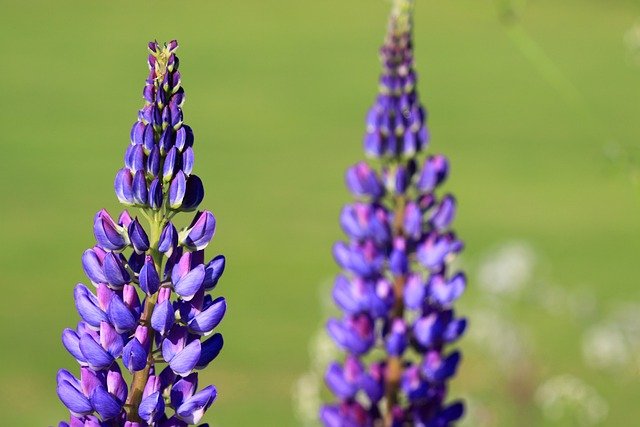
#15. Lupine Flower
Lupine flowers come in a range of colors, including blue, purple, pink, red, and white. The flowers are arranged in tall spikes that can be 1-2 feet (30-60 cm) long, and are attractive to bees and other pollinators.
- Scientific Name: Lupinus
- Plant Type: Lupine is a herbaceous perennial plant that is grown for its showy, spiky flowers.
- Sunlight Needs: Lupine prefers full sunlight to partial shade.
- Plant Size: The size of the Lupine plant can vary depending on the cultivar and growing conditions, but on average it grows to be about 1-4 feet (30-120 cm) tall and 1-3 feet (30-90 cm) wide.
- Growing Zones: Lupine is hardy in USDA growing zones 3-9, depending on the cultivar. It is native to North America, Europe, and Asia.
- Soil Needs: Lupine prefers well-draining soil that is slightly acidic to neutral (pH 6.0-7.0). It is a nitrogen-fixing plant, meaning it can convert atmospheric nitrogen into a form that can be used by other plants.

#16. Heliotrope Flower
Heliotrope flowers are known for their sweet, vanilla-like fragrance, which is most pronounced in the evening. The flowers are small, typically purple or white, and arranged in clusters that can be 4-6 inches (10-15 cm) across.
- Scientific Name: Heliotropium arborescens
- Plant Type: Heliotrope is a shrub-like, herbaceous perennial plant that is grown for its fragrant, showy flowers.
- Sunlight Needs: Heliotrope prefers full sunlight to partial shade.
- Plant Size: The size of the Heliotrope plant can vary depending on the cultivar and growing conditions, but on average it grows to be about 1-3 feet (30-90 cm) tall and 1-2 feet (30-60 cm) wide.
- Growing Zones: Heliotrope is hardy in USDA growing zones 10-11, but can be grown as an annual in cooler climates. It is native to Peru and Ecuador.
- Soil Needs: Heliotrope prefers well-draining soil that is slightly acidic to neutral (pH 6.0-7.0). It is moderately tolerant of drought and heat, but requires regular watering in hot, dry weather.
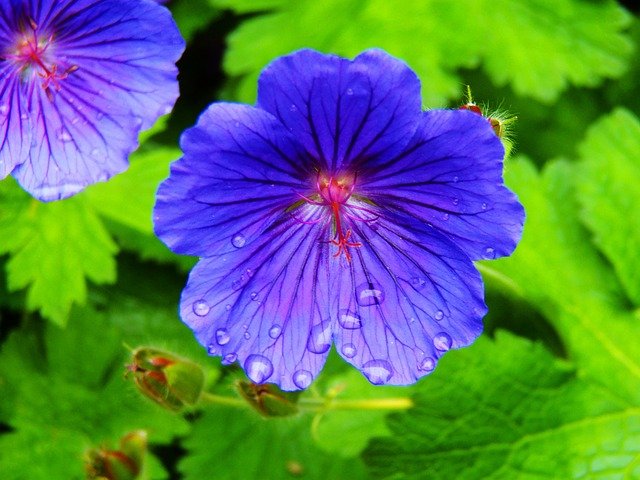
#17. Hardy Geranium
Hardy Geranium flowers come in a range of colors, including pink, purple, blue, and white. The flowers are typically arranged in clusters or umbels, and are attractive to bees and other pollinators. The foliage of Hardy Geraniums is often highly ornamental, and can be variegated or deeply lobed.
- Scientific Name: Geranium spp.
- Plant Type: Hardy Geraniums, also known as Cranesbills, are herbaceous perennials that are grown for their attractive foliage and showy flowers.
- Sunlight Needs: Hardy Geraniums prefer full sunlight to partial shade.
- Plant Size: The size of the Hardy Geranium plant can vary depending on the cultivar and growing conditions, but on average it grows to be about 1-2 feet (30-60 cm) tall and wide.
- Growing Zones: Hardy Geraniums are generally hardy in USDA growing zones 4-8, depending on the cultivar. They are native to temperate regions of the Northern Hemisphere.
- Soil Needs: Hardy Geraniums prefer well-draining soil that is slightly acidic to neutral (pH 6.0-7.0). They are generally tolerant of a range of soil types and moisture levels.

#18. Dendrobium Orchid Flower
Dendrobium Orchids are known for their showy and exotic flowers, which can come in a wide range of colors and patterns. The flowers are typically arranged in racemes or panicles and are attractive to butterflies and other pollinators. The foliage of Dendrobium Orchids is often highly ornamental,
- Scientific Name: Dendrobium spp.
- Plant Type: Dendrobium Orchids are a diverse group of epiphytic or lithophytic orchids that are prized for their beautiful and exotic flowers.
- Sunlight Needs: Dendrobium Orchids prefer bright, indirect light. They can be grown in full sun if protected from the hottest rays, but also can be grown in low light conditions.
- Plant Size: The size of the Dendrobium Orchid plant can vary depending on the species and growing conditions, but on average they grow to be about 1-4 feet (30-120 cm) tall.
- Growing Zones: Dendrobium Orchids are commonly grown as houseplants, but some species can be grown outdoors in tropical or subtropical regions. They are native to a wide range of regions, including Asia, Australia, and the Pacific Islands.
- Soil Needs: Dendrobium Orchids do not require soil and are typically grown in a well-draining potting mix that is specifically formulated for orchids. They require a mix that has a lot of air and drainage, like bark chips, perlite, or sphagnum moss.

#19. Coneflower
Coneflowers are known for their showy, daisy-like flowers, which can come in a wide range of colors including pink, purple, white, and yellow. The flowers are typically arranged in a cone-shaped center, surrounded by drooping petals. Coneflowers are attractive to bees,
- Sure, here is some information about the coneflower:
- Scientific Name: Echinacea spp.
- Plant Type: Coneflowers are herbaceous perennials that are grown for their attractive flowers and drought tolerance.
- Sunlight Needs: Coneflowers prefer full sunlight, but can also tolerate partial shade.
- Plant Size: The size of the coneflower plant can vary depending on the cultivar and growing conditions, but on average they grow to be about 1-3 feet (30-90 cm) tall and 1-2 feet (30-60 cm) wide.
- Growing Zones: Coneflowers are hardy in USDA growing zones 3-9, depending on the cultivar. They are native to the prairies and woodlands of North America.
- Soil Needs: Coneflowers prefer well-draining soil that is slightly acidic to neutral (pH 6.0-7.0). They are tolerant of a range of soil types and moisture levels, but prefer soil that is not overly wet.

#20. Cattleya Orchids Flower
Cattleya Orchids are known for their large and colorful flowers, which can come in a wide range of colors and patterns. The flowers are typically arranged in a spray or raceme, and can be highly fragrant. Cattleya Orchids are prized for their ornamental foliage, which can be broad
- Scientific Name: Cattleya spp.
- Plant Type: Cattleya Orchids are a group of epiphytic or lithophytic orchids that are prized for their showy and fragrant flowers.
- Sunlight Needs: Cattleya Orchids prefer bright, indirect light. They can tolerate some direct sunlight, but should be protected from the hottest rays.
- Plant Size: The size of the Cattleya Orchid plant can vary depending on the species and growing conditions, but on average they grow to be about 1-2 feet (30-60 cm) tall and wide.
- Growing Zones: Cattleya Orchids are typically grown as houseplants, but some species can be grown outdoors in warm, humid climates. They are native to Central and South America.
- Soil Needs: Cattleya Orchids do not require soil and are typically grown in a well-draining potting mix that is specifically formulated for orchids. They require a mix that has a lot of air and drainage, like bark chips, perlite, or sphagnum moss.

#21. Hollyhock Flower
Hollyhocks are known for their tall, stately flower spikes, which can come in a wide range of colors including pink, red, yellow, white, and purple. The flowers are arranged in a raceme, and are typically large and showy with a distinctive central stamen. Hollyhocks are attractive to bees and butterflies, and are often used in cottage gardens and as background plantings. T
- Scientific Name: Alcea spp.
- Plant Type: Hollyhocks are herbaceous biennials or short-lived perennials that are grown for their tall, showy flower spikes.
- Sunlight Needs: Hollyhocks prefer full sun, but can tolerate some light shade in the hottest part of the day.
- Plant Size: Hollyhocks can grow to be quite tall, typically reaching heights of 5-8 feet (1.5-2.4 m) or more, depending on the variety.
- Growing Zones: Hollyhocks are hardy in USDA growing zones 3-9, depending on the variety. They are native to Europe and Asia.
- Soil Needs: Hollyhocks prefer fertile, well-draining soil that is slightly acidic to neutral (pH 6.0-7.0). They are tolerant of a range of soil types, but do best in soil that is rich in organic matter.
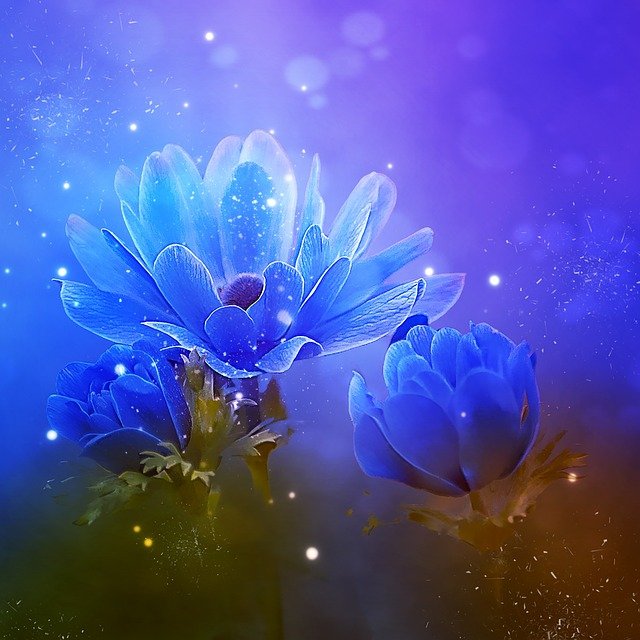
#22. Anemone Flower
Anemones are known for their colorful, daisy-like flowers, which can come in a wide range of colors including white, pink, red, and blue. The flowers are arranged in a single or double layer of petals and have a distinctive central disc. Anemones are attractive to bees and butterflies,
- Scientific Name: Anemone spp.
- Plant Type: Anemones are herbaceous perennials that are grown for their showy, daisy-like flowers.
- Sunlight Needs: Anemones prefer partial shade to full sun, depending on the variety.
- Plant Size: Anemones can range in size from dwarf varieties that grow only a few inches tall to taller varieties that can reach heights of 2-4 feet (60-120 cm).
- Growing Zones: Anemones are hardy in USDA growing zones 4-8, depending on the variety. Some species are native to North America, while others are native to Europe and Asia.
- Soil Needs: Anemones prefer well-draining soil that is rich in organic matter. They prefer slightly acidic soil (pH 6.0-7.0) and may benefit from an annual application of compost or organic fertilizer.

#23. Lily of the Nile Flower
Lily of the Nile is known for its striking, globe-shaped flower clusters, which can come in a range of blue, purple, white, and pink shades. The flowers are arranged in an umbel, and are typically quite showy with long, strap-like petals. Lily of the Nile is attractive to bees and butterflies,
- Scientific Name: Agapanthus spp.
- Plant Type: Lily of the Nile is a herbaceous perennial that is grown for its striking, globe-shaped flower clusters.
- Sunlight Needs: Lily of the Nile prefers full sun to partial shade.
- Plant Size: Lily of the Nile can grow to be quite large, typically reaching heights of 2-4 feet (0.6-1.2 m) and widths of 1-3 feet (0.3-0.9 m).
- Growing Zones: Lily of the Nile is hardy in USDA growing zones 8-11. It is native to South Africa.
- Soil Needs: Lily of the Nile prefers well-draining soil that is rich in organic matter. It can tolerate a range of soil types, but does best in soil that is slightly acidic to neutral (pH 6.0-7.0).

#24. Catmint Flower
Catmint is known for its aromatic, gray-green foliage and showy spikes of lavender-blue flowers. The flowers are attractive to bees, butterflies, and hummingbirds. Catmint is often used in borders, rock gardens,
- Scientific Name: Nepeta spp.
- Plant Type: Catmint is a herbaceous perennial that is grown for its attractive foliage and showy, aromatic flowers.
- Sunlight Needs: Catmint prefers full sun, but can tolerate some light shade.
- Plant Size: Catmint can grow to be 1-3 feet (0.3-0.9 m) tall and wide, depending on the variety.
- Growing Zones: Catmint is hardy in USDA growing zones 3-8, depending on the variety. It is native to Europe and Asia.
- Soil Needs: Catmint prefers well-draining soil that is moderately fertile. It can tolerate a range of soil types, but does best in soil that is neutral to slightly alkaline (pH 6.0-7.5).

#25. Iris Pumila
Iris Pumila is known for its attractive, showy flowers that come in a range of colors, including purple, blue, pink, white, and yellow. The flowers are arranged in a fan shape, with three petals and three sepals.
- Scientific Name: Iris pumila
- Plant Type: Iris Pumila is a herbaceous perennial that is grown for its attractive flowers.
- Sunlight Needs: Iris Pumila prefers full sun, but can tolerate some light shade.
- Plant Size: Iris Pumila typically grows to be 6-8 inches (15-20 cm) tall, with a spread of 12-18 inches (30-45 cm).
- Growing Zones: Iris Pumila is hardy in USDA growing zones 3-9.
- Soil Needs: Iris Pumila prefers well-draining soil that is slightly acidic to neutral (pH 6.0-7.0). It can tolerate a range of soil types, but does best in soil that is not too wet.

#26. Purple Pansy Flower
Purple Pansies are part of the viola family and are known for their attractive, heart-shaped flowers. The flowers come in a range of colors including purple, yellow, white, blue, and red. Purple Pansies are often used in borders,
- Scientific Name: Viola tricolor hortensis
- Plant Type: The Purple Pansy is a herbaceous biennial or annual flowering plant that is grown for its colorful flowers.
- Sunlight Needs: Purple Pansies prefer full sun to partial shade.
- Plant Size: Purple Pansies can grow up to 6-9 inches (15-23 cm) tall and can spread up to 9-12 inches (23-30 cm) wide.
- Growing Zones: Purple Pansies are hardy in USDA growing zones 4-8.
- Soil Needs: Purple Pansies prefer well-drained soil that is moist and fertile. The soil pH should be neutral to slightly alkaline (pH 6.0-7.5).

#27. Annual Honesty
Flower
Annual Honesty is known for its attractive, fragrant flowers that come in shades of purple, pink, and white. The flowers are arranged in clusters at the top of the stem. After the flowers have faded, the plant produces unique,
- Scientific Name: Lunaria annua
- Plant Type: Annual Honesty is an herbaceous biennial or annual flowering plant that is grown for its attractive flowers and unique seed pods.
- Sunlight Needs: Annual Honesty prefers full sun to partial shade.
- Plant Size: Annual Honesty can grow up to 2-3 feet (60-90 cm) tall and can spread up to 1-2 feet (30-60 cm) wide.
- Growing Zones: Annual Honesty is hardy in USDA growing zones 4-8.
- Soil Needs: Annual Honesty prefers well-drained soil that is moist and fertile. The soil pH should be neutral to slightly alkaline (pH 6.0-7.5).

#28. Bee Orchid
Flower
Bee Orchid is named for its flowers, which resemble a female bee and attract male bees for pollination. The flowers are generally pinkish-purple with a large, furry lip that resembles a bee. Bee Orchid is native to Europe and can be found in meadows, grasslands,
- Scientific Name: Ophrys apifera
- Plant Type: Bee Orchid is a perennial flowering plant that is grown for its unique and showy flowers.
- Sunlight Needs: Bee Orchid prefers full sun to partial shade.
- Plant Size: Bee Orchid can grow up to 12-24 inches (30-60 cm) tall and can spread up to 6-12 inches (15-30 cm) wide.
- Growing Zones: Bee Orchid is hardy in USDA growing zones 6-9.
- Soil Needs: Bee Orchid prefers well-drained soil that is neutral to slightly acidic (pH 6.0-7.0)
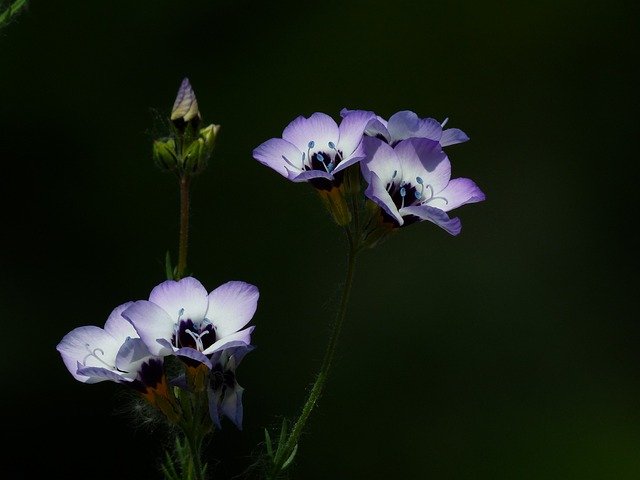
#29. Bell Heather
Flower
: Bell Heather is native to western Europe and is commonly found in heathlands, moorlands, and other open habitats. It is known for its attractive, bell-shaped flowers that come in shades of pink, purple, and white.
- Scientific Name: Erica cinerea
- Plant Type: Bell Heather is a low-growing evergreen shrub that is grown for its attractive flowers and foliage.
- Sunlight Needs: Bell Heather prefers full sun to partial shade.
- Plant Size: Bell Heather can grow up to 1-2 feet (30-60 cm) tall and can spread up to 2-3 feet (60-90 cm) wide.
- Growing Zones: Bell Heather is hardy in USDA growing zones 6-9.
- Soil Needs: Bell Heather prefers well-drained soil that is acidic (pH 4.5-6.0).
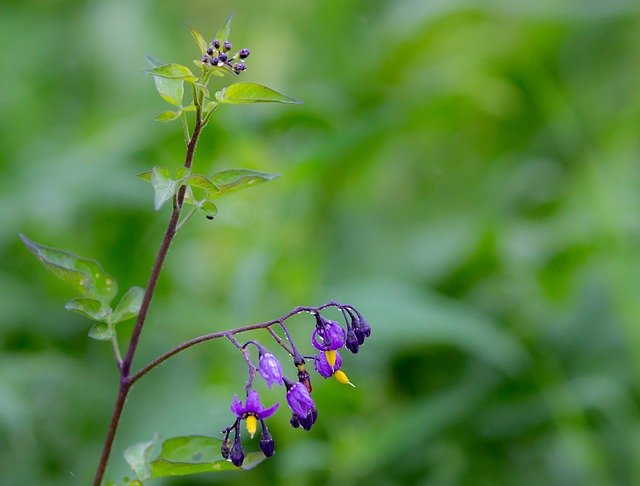
#30. Bittersweet Nightshade
Flower
: Bittersweet Nightshade is native to Europe, Asia, and North America and can be found in a variety of habitats, including wetlands, forests, and disturbed areas. It is known for its attractive,
- Scientific Name: Solanum dulcamara
- Plant Type: Bittersweet Nightshade is a woody perennial vine that is grown for its attractive flowers and berries.
- Sunlight Needs: Bittersweet Nightshade prefers full sun to partial shade.
- Plant Size: Bittersweet Nightshade can grow up to 10-12 feet (3-3.6 meters) long.
- Growing Zones: Bittersweet Nightshade is hardy in USDA growing zones 3-9.
- Soil Needs: Bittersweet Nightshade prefers well-drained soil that is neutral to slightly acidic (pH 6.0-7.0).
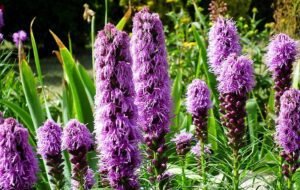
#31. Blazing Stars
Blazing Stars are native to North America and are commonly found in meadows, prairies, and other open habitats. They are known for their long, spiky flowers that come in shades of pink, purple, and white.
- Scientific Name: Liatris spicata
- Plant Type: Blazing Stars, also known as Gayfeather, are herbaceous perennial plants that are grown for their tall, spiky flowers.
- Sunlight Needs: Blazing Stars prefer full sun to partial shade.
- Plant Size: Blazing Stars can grow up to 2-5 feet (60-150 cm) tall and 1-2 feet (30-60 cm) wide.
- Growing Zones: Blazing Stars are hardy in USDA growing zones 3-9.
- Soil Needs: Blazing Stars prefer well-drained soil that is moist and slightly acidic to neutral (pH 6.0-7.0).

